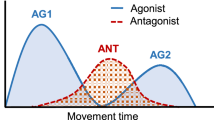Abstract
The purpose of this study was to fully characterize the timing and intensity of the phasic portion of the electromyographic (EMG) waveform for reaching movements in vertical planes. Electromyographic activity was simultaneously recorded from nine superficial elbow and/or shoulder muscles while human subjects made rapid arm movements. Hand paths comprised 20 directions in a sagittal plane and 20 directions in a frontal plane. In order to focus on the more phasic aspects of muscle activation, estimates of postural EMG activity were subtracted from the EMG traces recorded during rapid reaches. These postural estimates were obtained from activity recorded during very slow reaches to the same targets. After subtraction of this postural activity, agonist or antagonist burst patterns were often observed in the phasic EMG traces. For nearly all muscles and all subjects, the relation between phasic EMG intensity and movement direction was a function with multiple peaks. For all muscles, the timing of phasic EMG bursts varied as a function of movement direction: the data from each muscle exhibited a gradual temporal shift of activity over a certain range of directions. This gradual temporal shift has no obvious correspondence to the mechanical requirements of the task and might represent a neuromuscular control strategy in which burst timing contributes to the specification of movement direction.
Similar content being viewed by others
References
Buchanan TS, Almdale DPJ, Lewis JL, Rymer WZ (1986) Characteristics of synergic relations during isometric contractions of human elbow muscles. J Neurophysiol 56:1225–1241
Buchanan TS, Rovai GP, Rymer WZ (1989) Strategies for muscle activation during isometric torque generation at the human elbow. J Neurophysiol 62:1201–1212
Buneo CA, Soechting JF, Flanders M (1994) Muscle activation patterns for reaching: the representation of distance and time. J Neurophysiol 71:1546–1558
Buneo CA, Boline J, Soechting JF, Poppele RE (1995) On the form of the internal model for reaching. Exp Brain Res 104:467–479
Cheney PD, Fetz EE, Mewes K (1991) Neural mechanisms underlying cortico spinal and rubrospinal control of limb movements. Prog Brain Res 87:213–252
Fetz EE (1992) Are movement parameters recognizably coded in the activity of single neurons? Behav Brain Sci 15:679–690
Flanders M (1991) Temporal patterns of muscle activation for arm movements in three-dimensional space. J Neurosci 11:2680–2693
Flanders M (1993) Shoulder muscle activity during natural arm movements: What is optimized? In: Matsen FA (ed) The shoulder: a balance of mobility and stability. American Academy of Orthopaedic Surgeons, Rosemont, IL, pp 635–645
Flanders M, Herrmann U (1992) Two components of muscle activation: scaling with the speed of arm movement. J Neurophysiol 67:931–943
Flanders M, Soechting JF (1990) Arm muscle activation for static forces in three-dimensional space. J Neurophysiol 64, 1818–1837
Flanders M, Pellegrini JJ, Soechting JF (1994) Spatial/temporal characteristics of a motor pattern for reaching. J Neurophysiol 71:811–813
Garland SJ, Cooke JD, Ohtsuki T (1994) Lack of task-related motor unit activity in human triceps brachii muscle during elbow movements. Neurosci Lett 170:1–4
Georgopoulos AP (1991) Higher order motor control. Annu Rev Neurosci 14:361–377
Georgopoulos AP, Kalaska JF, Caminiti R, Massey JT (1982) On the relations between the direction of two-dimensional arm movements and cell discharge in primate motor cortex. J Neurosci 2:1527–1537
Georgopoulos AP, Caminiti R, Kalaska JF, Massey JT (1983) Spatial coding of movement: a hypothesis concerning the coding of movement direction by motor cortical populations. Exp Brain Res [Suppl] 7:327–336
Georgopoulos AP, Schwartz AB, Kettner RE (1986) Neuronal population coding of movement direction. Science 233:1416–1419
Georgopoulos AP, Lurito J, Petrides M, Schwartz AB, Massey JT (1989) Mental rotation of the neuronal population vector. Science 243:234–236
Haar Romeny BM ter, Denier van der Gon JJ, Gielen CCAM (1982) Changes in recruitment order of motor units in the human biceps muscle. Exp Neurol 78:360–368
Haar Romeny BM ter, Denier van der Gon JJ, Gielen CCAM (1984) Relations between location of a motor unit in the human biceps brachii and its critical firing levels for different tasks. Exp Neurol 85:631–650
Hoffman DS, Strick PL (1986) Activity of wrist muscles during step-tracking movements in different directions. Brain Res 367:287–291
Kalaska JF, Cohen DA, Hyde ML, Prud'homme MA (1989) Comparison of movement direction-related versus load direction-related activity in primate motor cortex using a two-dimensional reaching task. J Neurosci 9:2080–2102
Karst GM, Hasan Z (1991a) Initiation rules for planar, two-joint arm movements: agonist selection for movements throughout the work space. J Neurophysiol 66:1579–1593
Karst GM, Hasan Z (1991b) Timing and magnitude of electromyographic activity for two-joint arm movements in different directions. J Neurophysiol 66:1594–1604
Pellegrini JJ, Flanders M (1996) Force path curvature and conserved features of muscle activation. Exp Brain Res 110:80–90
Shadmehr R, Mussa-Ivaldi FA (1994) Adaptive representation of dynamics during learning of a motor task. J Neurosci 14:3208–3224
Soechting JF, Buneo CA, Herrmann U, Flanders M (1995) Moving effortlessly in three dimensions: does Donders' law apply to arm movement? J Neurosci 15:6271–6280
Soechting JF, Flanders M (1997) Evaluating an integrated musculoskeletal model of the human arm. J Biomech Eng (in press)
Theeuwen M, Gielen CCAM, Miller LE, Doorenbosch C (1994) The relation between the direction dependence of electromyographic amplitude and motor unit recruitment thresholds during isometric contractions. Exp Brain Res 98:488–500
Wadman WJ, Denier van der Gon JJ, Derksen RJA (1980) Muscle activation patterns for fast goal-directed arm movements. J Hum Mov Stud 6:19–37
Wilkie DR (1956) The mechanical properties of muscle. Br Med Bull 12:177–182
Zajac FE (1989) Muscle and tendon: properties, models, scaling, and application to biomechanics and motor control. Crit Rev Biomed Eng 17:359–411
Zuylen EJ van, Gielen CCAM, Denier van der Gon JJ (1988) Coordination and inhomogeneous activation of human arm muscles during isometric torques. J Neurophysiol 60:1523–1548
Author information
Authors and Affiliations
Rights and permissions
About this article
Cite this article
Flanders, M., Pellegrini, J.J. & Geisler, S.D. Basic features of phasic activation for reaching in vertical planes. Exp Brain Res 110, 67–79 (1996). https://doi.org/10.1007/BF00241376
Received:
Accepted:
Issue Date:
DOI: https://doi.org/10.1007/BF00241376




